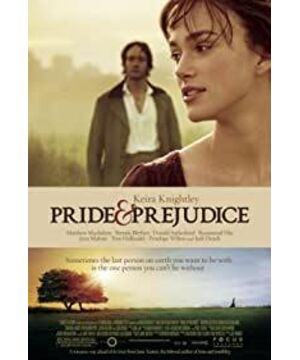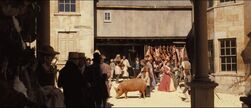The film is set in 1797, the year the first draft of the book took shape. The book Liz flipped through at the opening was titled First Impressions, the title Austen had originally planned for the book.
In the 18th century, some British historians summed up the Hanoverian dynasty before Victoria: George 1234 William 4. The period I pondered was after Victoria and really knew very little about George. The Georgian era in the film has strong associations with the countryside, and French/Continental influences are also evident.
Austin's preference is Derbyshire, and the film's focus is in the East Midlands, including Derbyshire and Lincolnshire.
Derbyshire: Darcy's home in Pemberley is Chatsworth House in Derbyshire. The Inn at Lambton in the film is Haddon Hall, and its dining room is set up as Liz's bedroom. The beauty of the Peak District ( http://en.wikipedia.org/wiki/Peak_district ) is featured repeatedly in the film.
Lincolnshire: The town of Stamford, George, was the filming location for the village of Meryton in the film.
Kent County: Burghley House, the mansion of the Duke (?) Lady, was shot in Rosings. Longbourn, where Liz's family lived, was in Groombridge Palce Gardens.
The above are sporadic notes, please refer to http://www.pemberley.com/janeinfo/ppjalmap.html for the full
record:
On November 25, about the interest of the Georgian era, read a more detailed explanation of Sister Tintin: http:/ /b-oo-k.net/blog/post/12/277
Two excerpts:
"Austin's life was under the rule of George III (1760–1820). From George I to the reign of four Georges IV (1714-1830), history is known as the Georgian period of Great Britain. I don't know if It was due to the venomous accusations against George III in the American Declaration of Independence. George III was insane during the last ten years of his reign, and his son, later George IV (1820-1830), acted as his father's regent under the Regency Act. The Prince of Wales, the Crown Prince of Wales, who served as regent, lived an unruly life in his early years. There were a group of lone dog gangs looking for fun, and the history was constant. Regent Street leads directly to the palace, which is convenient for him to visit. However, at a critical moment, the Regent decided to continue to serve as his father's prime minister, rather than his own playmates-the group of whigies who were planning to give up their confrontation with Napoleon-because of their insistence , Britain and its allies were finally able to defeat Nath in 1815. The Prince Regent is also a fan of his son Austin.
The architectural style of the Georgian period has begun to react to the Rococo style of the European Continent and return to the Renaissance. Classical Greece and Rome look for inspiration and aesthetic elements, which is called the "Neoclassical period" in history. The architectural lines are solemn but not heavy, concise but not dull, and can still be seen in the United Kingdom and the United States to this day. Jane. Austen's age, and the background she writes, is in the late 18th and early 19th centuries when "ha" Greece and the renaissance of antiquity; and the clothing written by women in her book is "neoclassical" Style, with Greek styling as a teacher. Clothing is a thing, as a symbol, like architecture, art, and literature, and it is immersed in the trend of the times and reflects the pulse of the times. "
View more about Pride & Prejudice reviews











